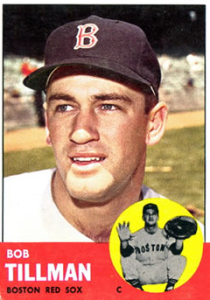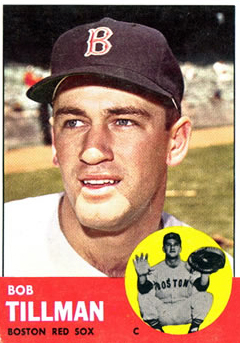May 19, 1962: In his third game, Boston’s Bob Tillman gets his first major-league at-bat and homers
 The year 1962 represented a solid start for Red Sox catcher Bob Tillman. He began his nine-year major-league career with a home run in his first at-bat.
The year 1962 represented a solid start for Red Sox catcher Bob Tillman. He began his nine-year major-league career with a home run in his first at-bat.
The following month, on June 26, Tillman caught a no-hitter thrown by Earl Wilson – a game in which Wilson himself provided the winning run with a third-inning solo home run off the California Angels’ Bo Belinsky. The final score was 2-0.1
By year’s end, Tillman had appeared in 81 of Boston’s 160 games, one of three catchers used by the Red Sox. Jim Pagliaroni appeared in 90 games and Russ Nixon in 65.2
Tillman made the club out of spring training that year, but had not been used much in the early going. His first plate appearance was in the season’s fourth game, the first game of a doubleheader in Baltimore on April 15. He was first up to bat in the top of the ninth, pinch-hitting for Mike Fornieles. The Orioles led, 5-1. The Orioles’ Steve Barber walked Tillman. He advanced to second and then third, but was left stranded 90 feet from home when Barber struck out Pagliaroni for the third out of the inning, ending the game.
Twenty-three games later, the Yankees were in Boston. The Red Sox had taken a 7-6 lead in the bottom of the eighth. Pagliaroni singled behind Carl Yastrzemski’s walk, with Lou Clinton pinch-running for Pagliaroni. Both runners scored, thus giving Boston the one-run edge. Tillman caught the top of the ninth, with Fornieles pitching. After two outs, Mickey Mantle walked and Yogi Berra singled to right. Rookie Dick Radatz relieved Fornieles, but faltered badly, giving up two singles and a double. New York took the lead back, 9-7.3 Jim Coates allowed the first two Red Sox to reach base, but Marshall Bridges was brought in from the bullpen and retired the next three batters, with Tillman in the on-deck circle as Yastrzemski grounded into a force play to end the game, a 9-8 New York win.
During the early part of the season, Tillman mostly sat on the bench, even though manager Pinky Higgins was apparently complaining that the team didn’t have enough right-handed power.4
But on May 19, Tillman got his first start. The Red Sox had lost three in a row and seven of their last nine. Higgins gave Tillman a chance to start the Saturday afternoon game catching Earl Wilson, a contest that was to go 10 innings. Tillman was penciled in batting fourth in the order.
Left-hander Ted Bowsfield, who had begun his career with the Red Sox, was manager Bill Rigney’s starting pitcher for the Angels. Bowsfield had been traded to Cleveland in 1960, and then was claimed by the Angels in the expansion draft before the 1961 season. At game time, he was 1-2 with a 7.58 ERA.
Wilson retired the Angels in order in the first inning. Pete Runnels led off with a single in the bottom of the first, but Bowsfield got Eddie Bressoud to hit into a 4-6-3 double play, and then Yastrzemski to ground out to first baseman Tom Burgess, Bowsfield taking the throw.
In the Angels’ second, Wilson walked one, but then got outs from the next three. Tillman was the first man up in Boston’s second inning and he drew a base on balls. After Frank Malzone flied out to center, Tillman was forced out at second on a goundball hit by Clinton, 6-4. Carroll Hardy grounded out, too, forcing another out at second.
Neither team had a baserunner in the third inning.
Second baseman Billy Moran started the top of the fourth with a home run off Wilson that nicked the left-most light tower atop the ballpark’s left-field wall. The next three Angels all hit the ball to the outfield, but all three were caught for outs. California had a 1-0 lead.
In the bottom of the fourth, both Bressoud and Yastrzemski grounded out, but Tillman tied it up on a 2-and-1 count with an opposite-field solo home run into the Red Sox bullpen in right field.
The game had drawn only 6,590 fans to Fenway Park, but those who came saw something special.5 Tillman’s homer had been in his third time in the batter’s box, and in his third game, but his first official big-league at-bat. The Red Sox took a 2-1 lead in the fifth, on Hardy’s walk, a pair of groundouts, and Runnels’ single to center.
In the top of the sixth, though, the Angels tipped the score the other way when Albie Pearson walked and Leon Wagner hit a two-run homer to right.
Tillman was the one who evened it back up. Yastrzemski led off with a triple that hit the straightaway center-field wall on one hop. Tillman hit a 400-foot sacrifice fly to center, on which Yastrzemski scored.6 For those keeping track, this was Tillman’s fourth plate appearance, and he added another RBI to his personal statistics, but as a sacrifice fly it did not count as an official at-bat.
Malzone walked, Tom Morgan relieved Bowsfield, and – after Gary Geiger grounded into a force play at second – Hardy homered into the net in center-left. It was Red Sox 5, Angels 3.
In the bottom of the seventh, with two outs and runners on first and second, reliever Art Fowler struck out Tillman.
The Angels tied it, 5-5, in the top of the eighth. After one out, Lee Thomas walked, Burgess doubled off the wall in left, and third baseman Félix Torres singled off Radatz to drive them both in. Radatz walked the next two batters and was relieved by Chet Nichols to close out the inning.
Dean Chance relieved Fowler and pitched the remainder of the game, allowing a leadoff single in the eighth and a leadoff walk in the bottom of the ninth. But then he buckled down to get three consecutive outs in each of the innings.
Nichols worked the rest of the game for the Red Sox. Moran doubled to lead off the ninth, but two foul popups and a groundout got him out of the inning. Boston failed to score in the bottom of the ninth, leaving the score tied 5-5.
The game went into extra innings, with bad weather threatening, but soon the “marathon struggle ended with the lights on amid thunder and lightning.”7
Nichols allowed shortstop Joe Koppe a one-out walk in the top of the 10th.8 Batting for himself, Chance bunted, a sacrifice to advance Koppe to second, from where he scored on Buck Rodgers’ single to right-center.
Tillman led off for the Red Sox and grounded out to the third baseman. Malzone singled, but neither Geiger nor Hardy could provide anything positive. The Angels won, 6-5.
“I’ll use Bob more often from now on,” manager Higgins said after the game.9
Tillman hit 14 homers in 1962, driving in 38 runs, but hit for a .229 batting average. He played in more games but was somewhat less productive in all three categories in 1963. His best season came in 1964, when he appeared in 131 games, hit .278, homered 17 times, and drove in 61 runs. His contract was sold to the New York Yankees in early August of 1967, and he was traded to the Atlanta Braves that winter, where he wrapped up his playing career after the 1970 season.
Sources
In addition to the sources cited in the Notes, the author consulted Baeball-Reference.com and Retrosheet.org.
https://www.baseball-reference.com/boxes/BOS/BOS196205190.shtml
https://www.retrosheet.org/boxesetc/1962/B05190BOS1962.htm
Photo credit: Bob Tillman, Trading Card Database.
Notes
1 Tillman was 0-for-4 in the June 26 game. He later caught another no-hitter, one which the author attended, by Dave Morehead, on September 16, 1965, also a 2-0 victory at Fenway Park, this time against the Cleveland Indians. There followed a nearly 37-year wait until the next Fenway no-hitter, thrown by Derek Lowe on April 27, 2002, in a 10-0 thumping of Tampa Bay.
2 Pagliaroni was the catcher for a second Red Sox no-hitter in 1962. At Comiskey Park on August 1, Bill Monbouquette no-hit the White Sox, 1-0. Pagliaroni scored the only run, after singling with two outs in the top of the eighth, then scoring on back-to-back singles by Pete Runnels and Lou Clinton. Early Wynn bore the loss.
3 By year’s end, though, Radatz had a 2.24 earned-run average and led the league with 24 saves.
4 Sportswriter John Gillooly asked, “Why is it Mike Higgins says all the time that he wants more power right-handed when all the time he has big boy Don Gile and Bob Tillman on the bench.” He suggested using Tillman in right field. John Gillooly, “No Buttons to Push So Stengel Just Bush,” Boston Record American, May 10, 1962: 43. Tillman had averaged over 20 home runs in four minor-league seasons and had played both at first base and in the outfield. Tim Horgan similarly noted the same lack of use of both Gile and Tillman. Tim Horgan, “What Will Sox Do with All That Lovely Money?,” Boston Traveler, May 20, 1962: 37, 38.
5 Tillman was the third Red Sox player to homer in his first at-bat. Before him had been Wilfred “Lefty” Lefebvre on June 10, 1938, and Eddie Pellagrini on April 22, 1946. The last opposing batter to homer in his first big-league at-bat at Fenway Park was Bob Nieman, who homered both his first and second times up against Maury McDermott on September 14, 1951.
6 Center fielder Albie Pearson “caught the ball with his back almost against the high center field bleacher wall.” Joe Cashman, “Kid Tillman Packs Punch,” Boston Sunday Advertiser, May 20, 1952: 34.
7 Braven Dyer, “Rodgers’ Blow Gives Angels Win in 10th, 6-5,” Los Angeles Times, May 20, 1962: D1.
8 The Globe’s Hy Hurwitz noted that three of the Angels’ runs came after bases on balls, which he called “the most damaging thing in baseball.” Hy Hurwitz, “Sox Shaded in 10th,” Boston Globe, May 20, 1962: 69.
9 Higgins did note that “Tillman is very dangerous at bat against left-handers. He also can hit a long ball against right-handers, but he doesn’t do it as often.” Cashman.
Additional Stats
Los Angeles Angels 6
Boston Red Sox 5
Fenway Park
Boston, MA
Box Score + PBP:
Corrections? Additions?
If you can help us improve this game story, contact us.


